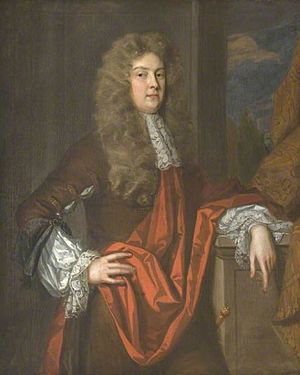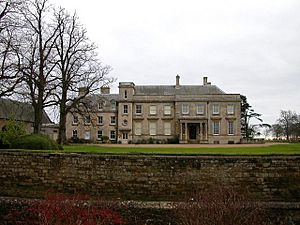Sir Justinian Isham, 4th Baronet facts for kids

Sir Justinian Isham, 4th Baronet (born August 11, 1658, died May 13, 1730) was an important English landowner. He was also a Tory politician. Sir Justinian was a member of the House of Commons, which is part of the British Parliament. He served almost continuously from 1685 until he passed away in 1730. For a short time, from 1729 to 1730, he was known as the "Father of the House". This title is given to the member who has served the longest.
Contents
Early Life and Family
Justinian Isham II was born on August 11, 1658. His father was Sir Justinian Isham, 2nd Baronet of Lamport. His mother was Vere Leigh. Her father was Thomas Leigh, 1st Baron Leigh.
Justinian went to Christ Church, Oxford in 1674. Later, he studied law at Lincoln's Inn in 1677. He did not finish his university degree.
In 1681, something unexpected happened. His older brother, Sir Thomas Isham, 3rd Baronet, died suddenly from smallpox. This meant Justinian became the 4th Baronet. He also inherited Lamport Hall in Northamptonshire.
On July 16, 1683, Justinian married Elizabeth Turnor in Stoke Rochford, Lincolnshire. Elizabeth (1666-1713) was the only daughter of Sir Edmund Turnor.
Political Career
Justinian Isham began his political journey in 1685. He was elected as a Member of Parliament (MP) for Northampton. He was elected again in 1689. However, he lost the election in 1690.
He returned to Parliament in 1694 after winning a special election. He was elected again for Northampton in 1695. In 1698, he was asked to run for Northamptonshire instead. Even with short notice, he won the election.
Serving in Parliament
Justinian was part of the Country Party. This group often disagreed with the King's government. He was sometimes absent from Parliament, likely due to family matters.
He was re-elected in 1701 and again in 1702. He supported actions that defended the House of Commons. In 1702, he received the most votes in his election.
In 1705, he won another election for Northamptonshire. He voted against the King's preferred candidate for Speaker of the House. He supported his cousin, William Bromley, for the role.
Later Years in Politics
In 1708, Justinian was re-elected without opposition. He often missed Parliament due to family life and poor health. However, he was able to vote against the impeachment of Dr. Sacheverell in 1710.
He was re-elected again in 1710. He was seen as a "Tory patriot" who supported peace. He also helped to show problems with the previous government. He was involved in a group called the October Club.
By 1713, Justinian was suffering from gout, a painful joint condition. His wife became very ill and passed away in August 1713. This was a very difficult time for him. He was very sad for about a year. He returned to public life in August 1714.
He was re-elected for Northamptonshire in 1715. From then on, he consistently voted with the opposition party. He was re-elected again in 1722 and 1727.
Death and Legacy
Sir Justinian Isham died on May 13, 1730, at the age of 72. He was buried at Lamport, next to his wife.
He and his wife had many children. Ten of them lived to adulthood, including three sons:
- Sir Justinian Isham (1687-1737), who became the 5th Baronet after his father.
- Sir Edmund Isham (1690-1772), who became the 6th Baronet after his brother died.
- Euseby Isham (1697-1755), who became the Vice-Chancellor of Oxford University. This is a very important leadership role at the university.
There are paintings of Sir Justinian Isham at Lamport Hall. One is thought to be by Michael Dahl, and another is by Godfrey Kneller.


